Overnight, Refrigerator Focaccia = The Best Focaccia Bread Recipe
This post may contain affiliate links. Please read my disclosure policy.
Cold, refrigerated dough is the secret to making delicious focaccia! Allowing the dough to rest 18 to 48 hours in the fridge will yield extra-pillowy and airy focaccia, though if you are pressed for time, you can make this start-to-finish in 3 hours. This 4-ingredient recipe requires only 5 minutes of hands-on time. Video guidance below!
⭐️⭐️⭐️⭐️⭐️ Review:
“Love this recipe! I’ve made this so many times that I’ve lost count. Super simple and delicious. My family loves it. Whenever someone asks me for a focaccia recipe, I always show them this one. This recipe is awesome. Thank you for sharing!” — Lucy
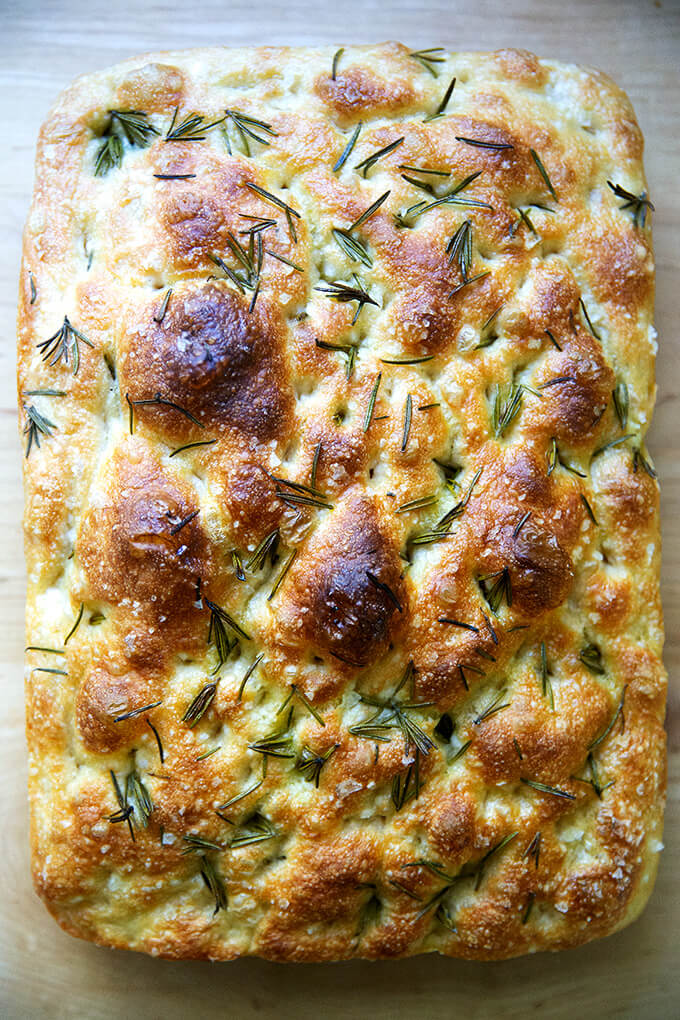
I’ve said it before and I’ll say it again: focaccia is the bread recipe for beginners. Why? Because:
- The no-knead, 4-ingredient dough takes 5 minutes to mix together.
- It requires no special equipment, no tricky shaping technique, and no scoring.
- If you have a 9×13-inch baking pan and your fingertips (for dimpling), you’re good to go.
- It emerges soft and pillowy, olive oil-crusted, golden all around, and it’s completely irresistible.
In sum, it’s hard to beat focaccia (pronounced foh-kah-chuh) in the effort-to-reward category. If you are intimidated by bread baking, this is the recipe I suggest making first, both for its simplicity and flavor. After all, this focaccia bread recipe is adapted from my mother’s simple peasant bread recipe, a recipe that has removed the fear of the bread baking process for many.
For the past few months, I’ve been making the focaccia bread recipe from my cookbook Bread Toast Crumbs, but changing the method: using more yeast, using less yeast, doing longer, slower rises at room temperature, doing longer, slower rises in the refrigerator. Find the results below.
This post is organized as follows:
- What Makes The Best Focaccia
- Four Tips for Success
- How This Focaccia Recipe Differs from Others
- Focaccia Bread Ingredients
- How to Make Focaccia, Step by Step
- Adding Rosemary, Herbs and Other Toppings to your Focaccia Dough
- How to Make a Focaccia Bread Art
- Tomato Focaccia
- How to Make a Focaccia Bread Sandwich
- Can I Skip the Overnight Rise?
PS: Once you master this simple focaccia, try your hand at this simple sourdough bread recipe, another recipe that requires minimal effort but yields spectacular results.
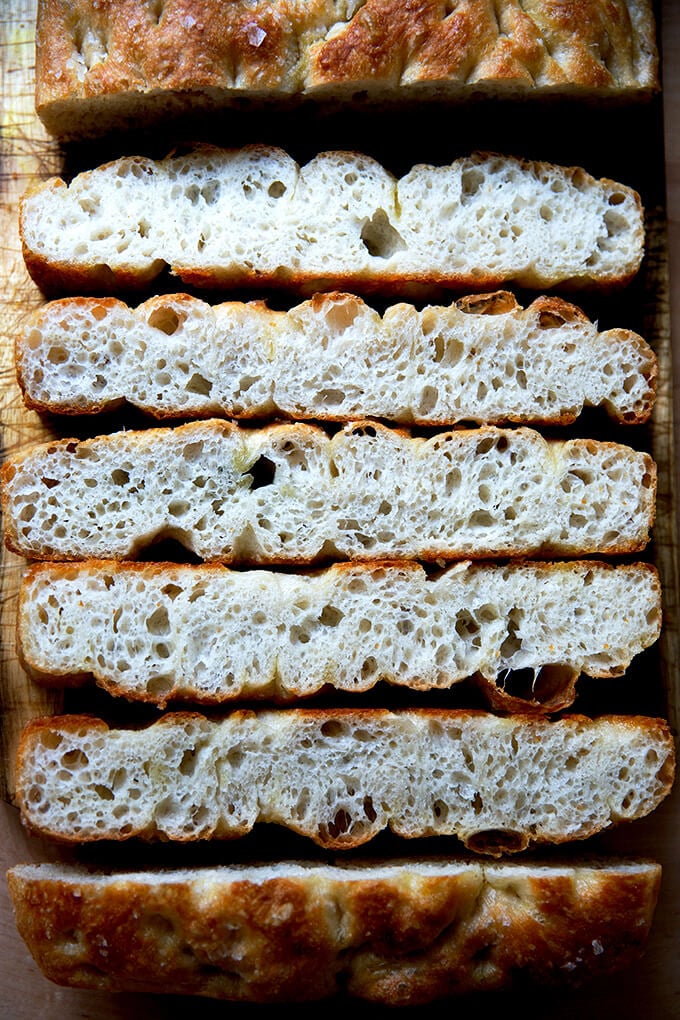
What Makes The Best Focaccia?
I’ll spare you all the details of the various experiments and skip straight to what I’ve found creates the best focaccia, one that emerges golden all around, looking like a brain, its surface woven with a winding labyrinth of deep crevices: high-hydration, refrigerated dough.
This is nothing novel—many bakers extol the virtues of the cold fermentation process—and it came as no surprise to me either: it was, after all, past-prime Jim Lahey refrigerated dough that showed me how easy focaccia could be: place cold, several-days-old pizza dough in a well-oiled pan, let it rise for several hours or until it doubles, drizzle with more oil, dimple with your fingers, sprinkle with sea salt, then bake until done.
Employing a refrigerator rise requires more time because the cold environment slows everything down initially, and during the second rise, the cold dough takes time to warm to room temperature. The overall effort, however, is very hands-off, and the result — a light, airy, pillowy dough — is well worth it.
As important as refrigerating the dough is using a high hydration dough, meaning a dough with a high proportion of water relative to the flour. The high proportion of water will create a dough with beautiful air pockets throughout. (Incidentally, this is the secret to making excellent pizza dough as well as light, airy sourdough sandwich bread.)
How This Focaccia Recipe Differs from Others
There are lots of focaccia bread recipes out there, so why make this one? This one differs from many of the recipes out there in two ways:
- The long, cold, refrigerator rise.
- The absence of sugar or honey or any sort of sweetener.
Why isn’t there any sweetener in this recipe? Simply stated, a sweetener is just not needed — the yeast, contrary to popular belief, does not need sugar to activate or thrive. Sugar will speed things up, but when you’re employing a long, slow rise, speed is not the name of the game.
Moreover, and this is getting a little scientific, but during the long, cold fermentation: enzymes in both the flour and the yeast will break down the starches in the flour into simple sugars, which will contribute both to flavor and to browning, again rendering sugar unnecessary. Cool, right?
Four Tips for Success
- Allowing the dough to rest 18 to 24 hours in the fridge yields the best results. (You can leave the dough in the fridge for as long as 72 hours.)
- A buttered or parchment-lined pan in addition to the olive oil will prevent sticking. When I use Pyrex or other glass pans, butter plus oil is essential to prevent sticking. When I use my 9×13-inch USA Pan, I can get away with using olive oil alone.
- Count on 2 to 4 hours for the second rise. This will depend on the temperature of your kitchen and the time of year.
- After the second rise, dimple the dough, then immediately stick the pans in the oven — this has been a critical difference for me in terms of keeping those desirable crevices. If you dimple and let the dough rise again even for 20 minutes before popping the pan in the oven, the crevices begin to dissolve.
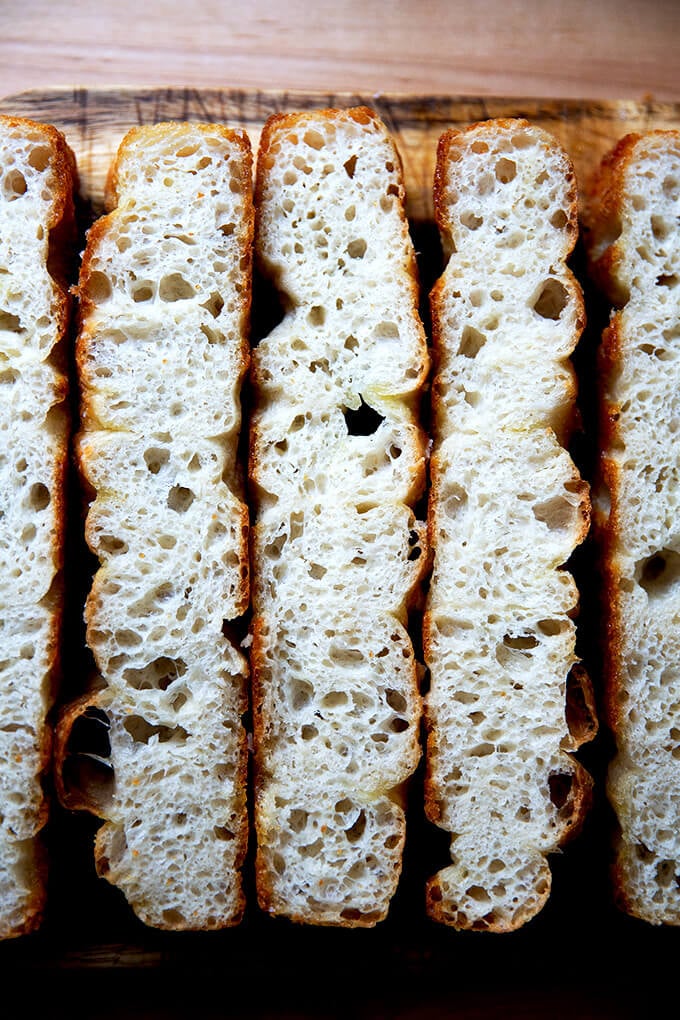
Ingredients
- Flour: bread flour or all-purpose flour will work equally well here. If you live in a humid environment or abroad, I suggest trying to get your hands on bread flour. King Arthur Flour is my preference.
- Yeast: SAF Instant Yeast is my preference, but active dry yeast works just as well. See recipe box for instructions on how to use active-dry yeast in place of instant.
- Salt: I say this all the time, but a big part of making a good loaf of bread comes down simply to using the right amount of salt given the amount of flour you are using by weight. It’s like anything: bread has to be well seasoned. At a minimum, use 10 grams (2 teaspoons) of salt for every 500 grams (4 cups) of flour. I highly recommend investing in some good, flaky sea salt for sprinkling on top of the focaccia dough — it tastes better than the more finely ground varieties of salt. I use Diamond Crystal kosher salt for the dough, but any salt you have on hand will work just fine for the dough.
- Water: There is a lot of water in this dough — it’s 88% hydration — and all of that water helps produce a light, airy, pillowy dough.
- Olive oil: Olive oil both in the bottom of the pan and on top of the dough is essential for encouraging nice browning, flavor, and that quintessential oiliness we all love about focaccia.
- Rosemary or other seasonings: Rosemary is a classic focaccia topping, and you can either sprinkle it over the dough before baking or you can chop it up and add it to the dough. Many people love sun-dried tomatoes and olives in their focaccia. See below for how to incorporate these other ingredients into your focaccia dough.
How to Make Focaccia Bread, Step by Step
Gather your ingredients: 4 cups (512 g) flour, 2 teaspoons (10 g) salt, 2 teaspoons (8 g) instant yeast (SAF is my preference), 2 cups (455 g) water:
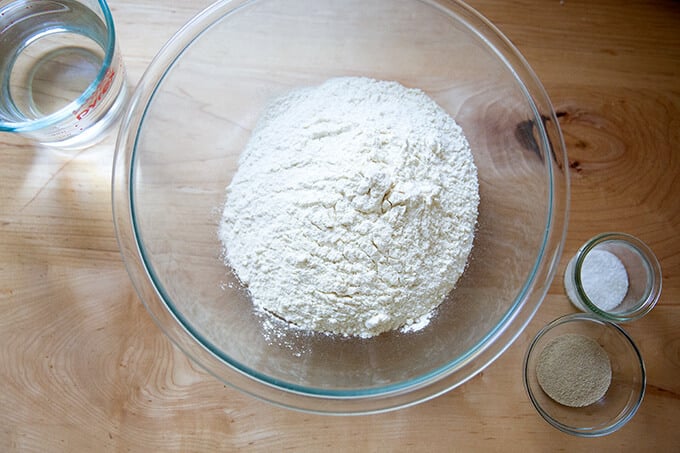
Whisk together the flour, salt, and yeast first:
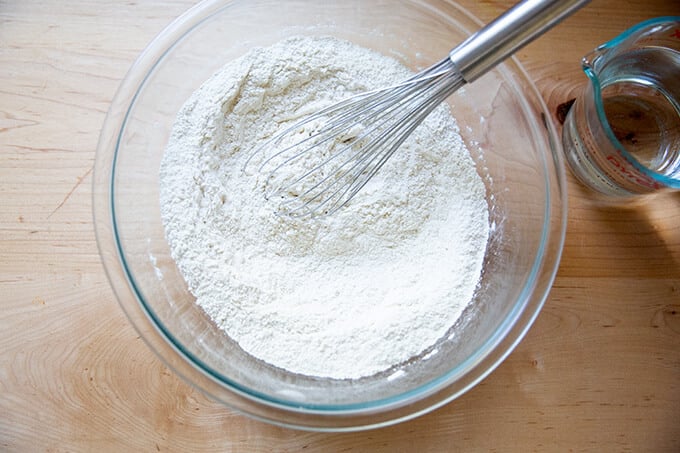
Add the water:
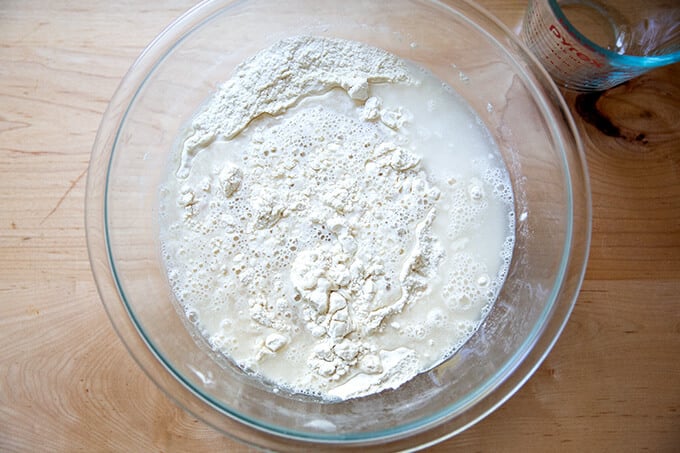
Use a spatula to stir the two together.
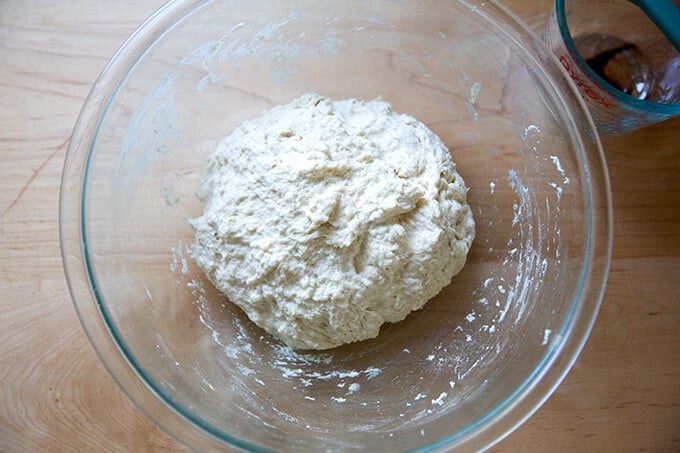
Slick the dough with olive oil:
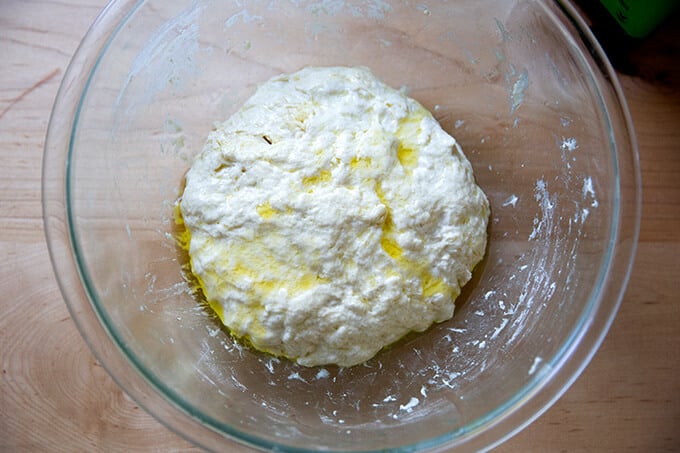
Slick the surface of the dough with olive oil; then cover the bowl. You all have one of these, right? Stick the bowl in the fridge immediately; leave it there to rise for 12 to 18 hours (or longer—I’ve left it there for as long as three days). NOTE: It is important the dough really be slicked with olive oil especially if you are using a cloth bowl cover or tea towel as opposed to plastic wrap or the lid pictured in the photo below this one. If you are using a tea towel, consider securing it with a rubber band to make a more airtight cover. If you do not slick the dough with enough oil, you risk the dough drying out and forming a crust over the top layer.
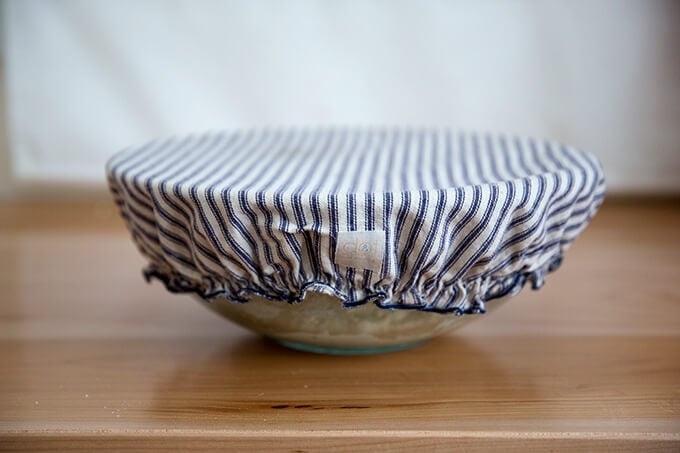
Another option: the lid that comes with the 4-Qt Pyrex bowl. This is handy for fridge storage because you can stack things on top of it.
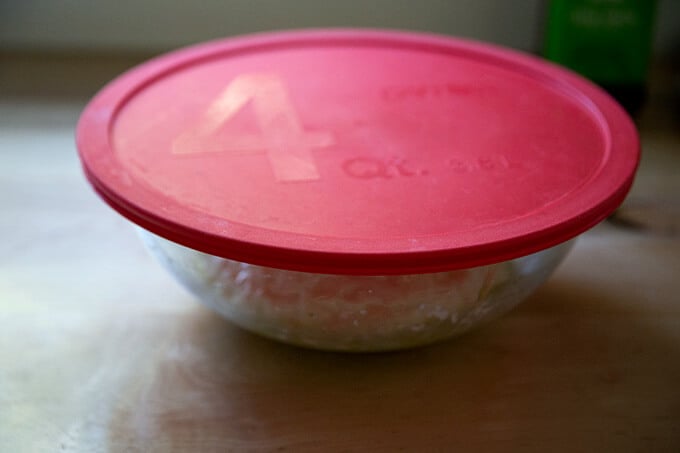
Remove from fridge, and remove the cover:
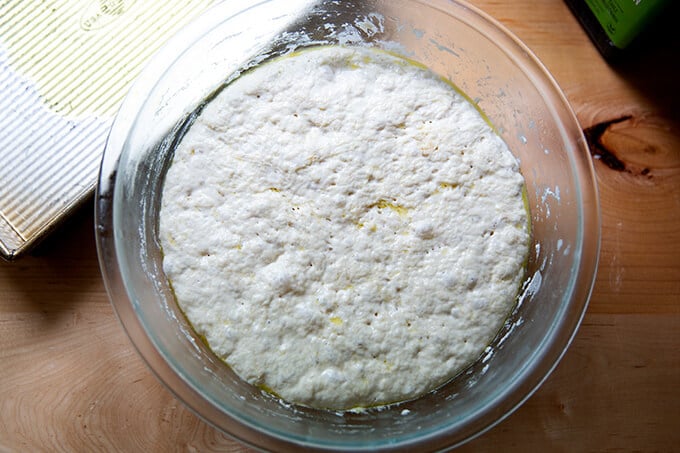
Deflate the dough and transfer to a prepared pan. I love this 9×13-inch USA pan. If you don’t have one you can use two 8- or 9-inch pie plates or something similar. If you are using glass baking dishes be sure to grease the dishes with butter before pouring a tablespoon of olive oil into each. (The butter will ensure the bread doesn’t stick.) Don’t touch the dough again for 2 to 4 hours depending on your environment.
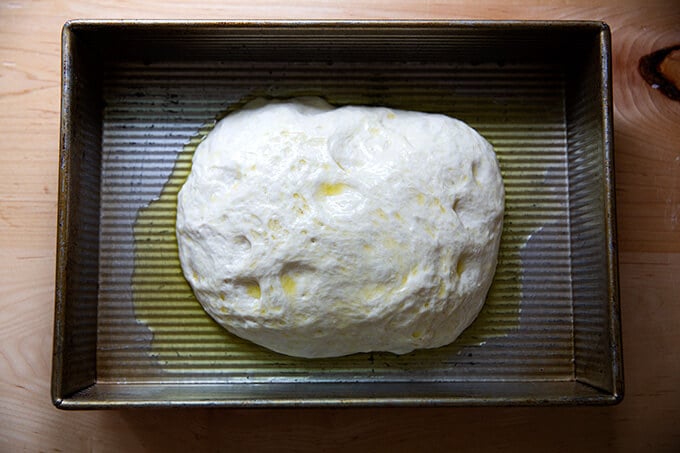
After two to four hours, or when the dough looks like this…:
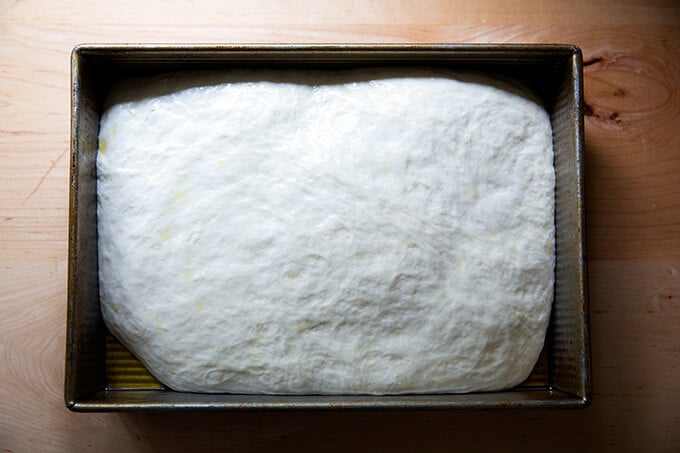
… it’s time to dimple it! You can use simply olive oil and salt — I recommend good, flaky sea salt for this. Note, the dough in the photo below spent three days in the fridge, and the dough was super bubbly!
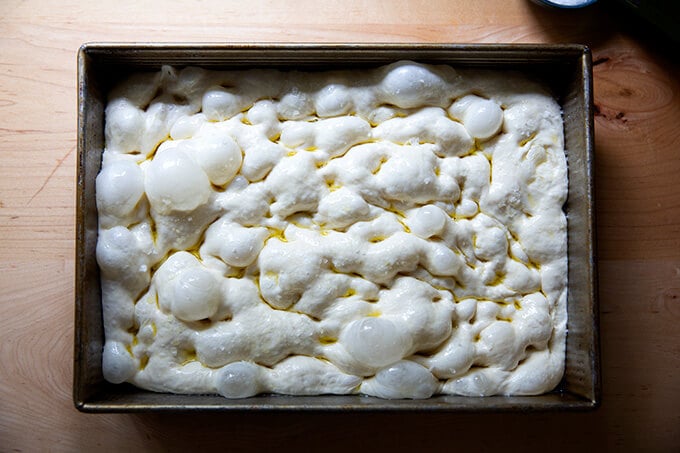
if you are using rosemary, sprinkle it over the dough. Then pour two tablespoons of olive oil over the dough, and using your fingers, press straight down to create deep dimples. Sprinkle with flaky sea salt — again, something like Maldon is great here.
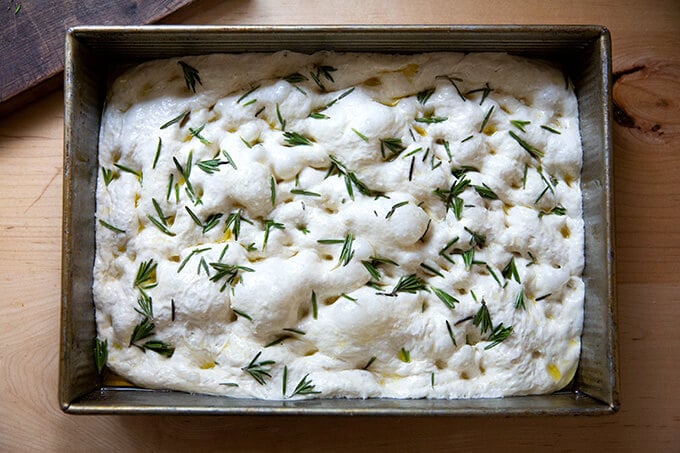
Transfer to oven immediately and bake at 425ºF for 25 minutes or until golden all around. Remove focaccia from pans and place on cooling racks.
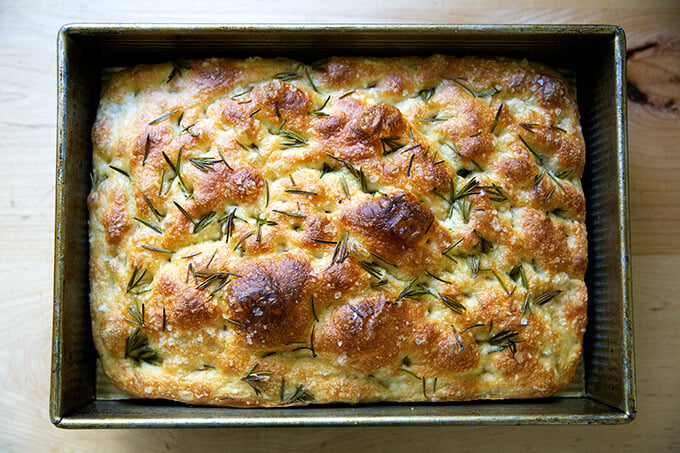

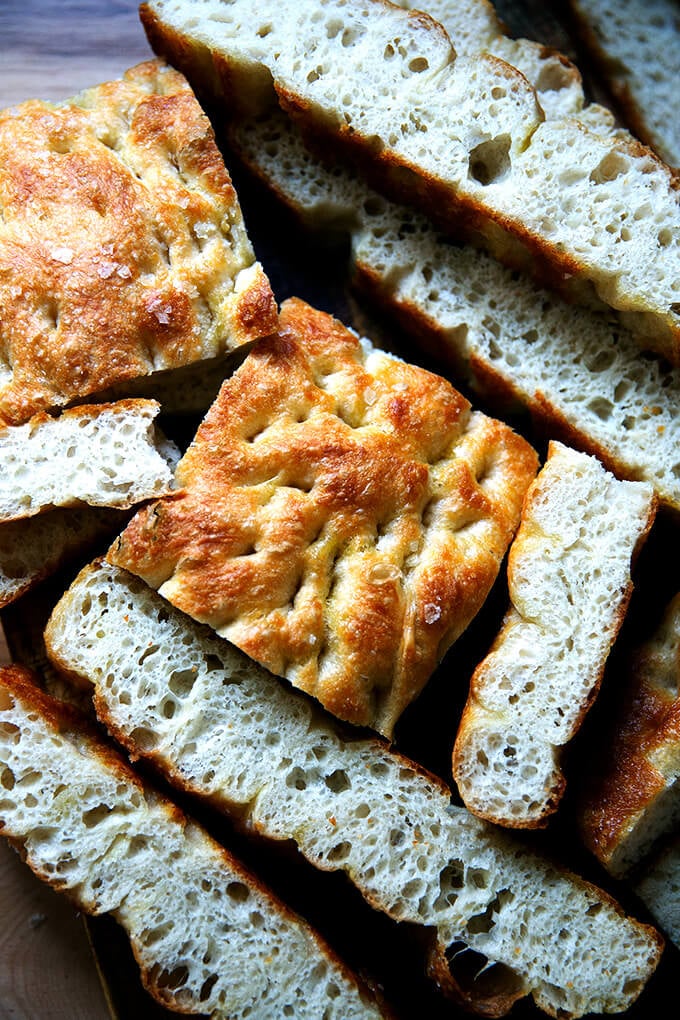
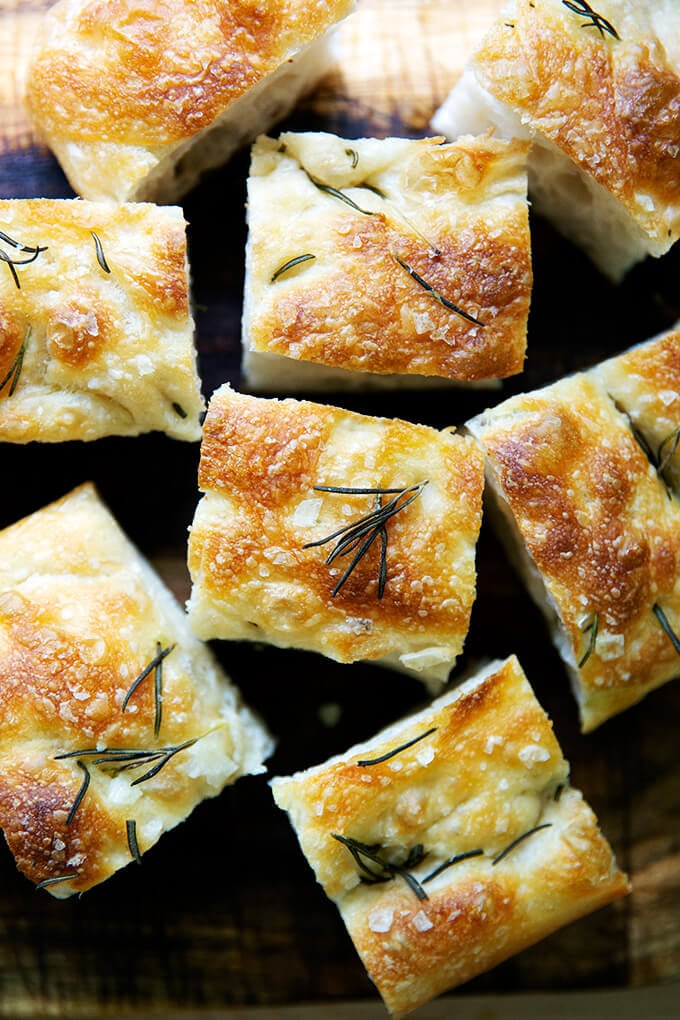
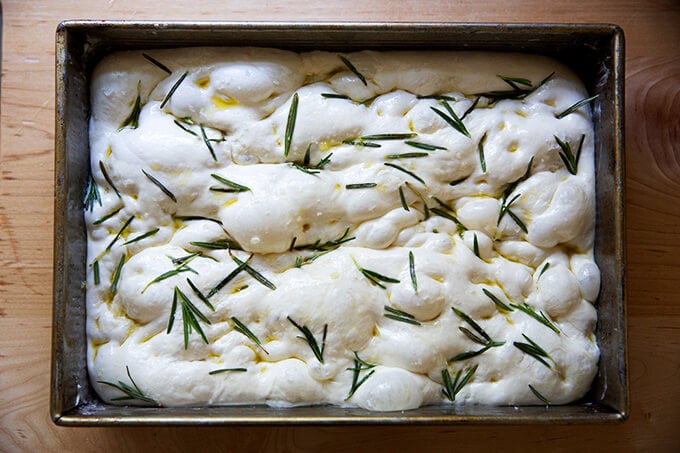
How to Incorporate Rosemary, Herbs, and Other Ingredients & Toppings into Your Focaccia Dough
One of the most frequently asked questions I get is: How can I add other toppings or ingredients to my focaccia bread? You can do this in two ways:
- Add them on top as you would rosemary or other herbs. The key is to make sure the ingredients are slicked lightly with olive oil to ensure they do not burn in the oven. I like to sprinkle the rosemary over top of the dough, then drizzle it with olive oil, then dimple the dough.
- You can add them directly to the dough. In step one, when you whisk together the flour, salt, and instant yeast, add your ingredients — chopped olives, sun-dried tomatoes, roasted garlic — to the flour and toss to coat; then add the water.
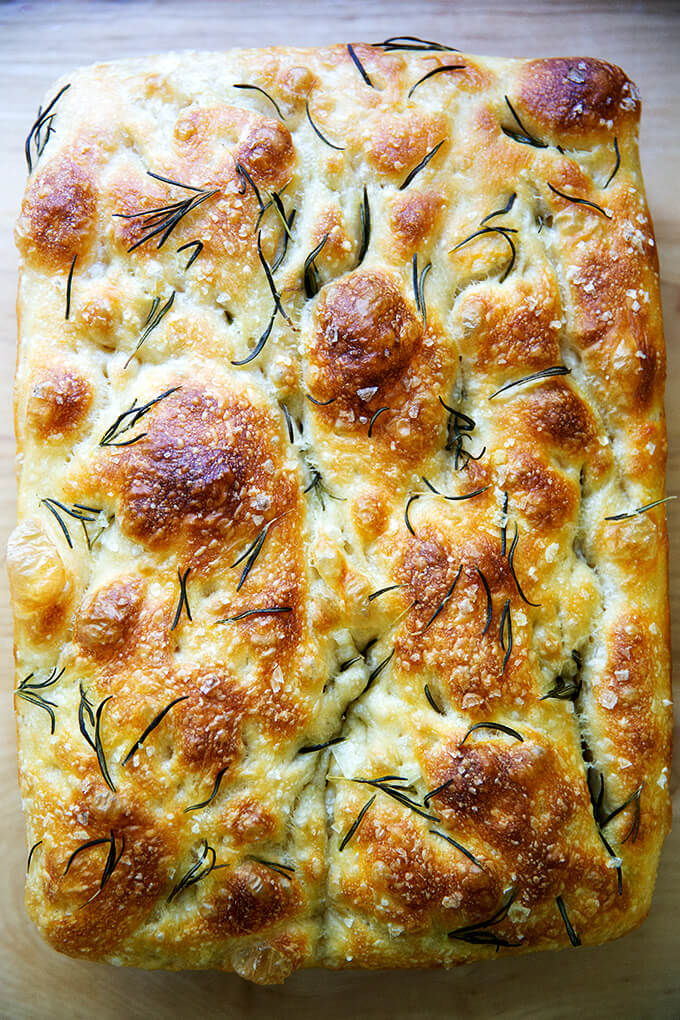
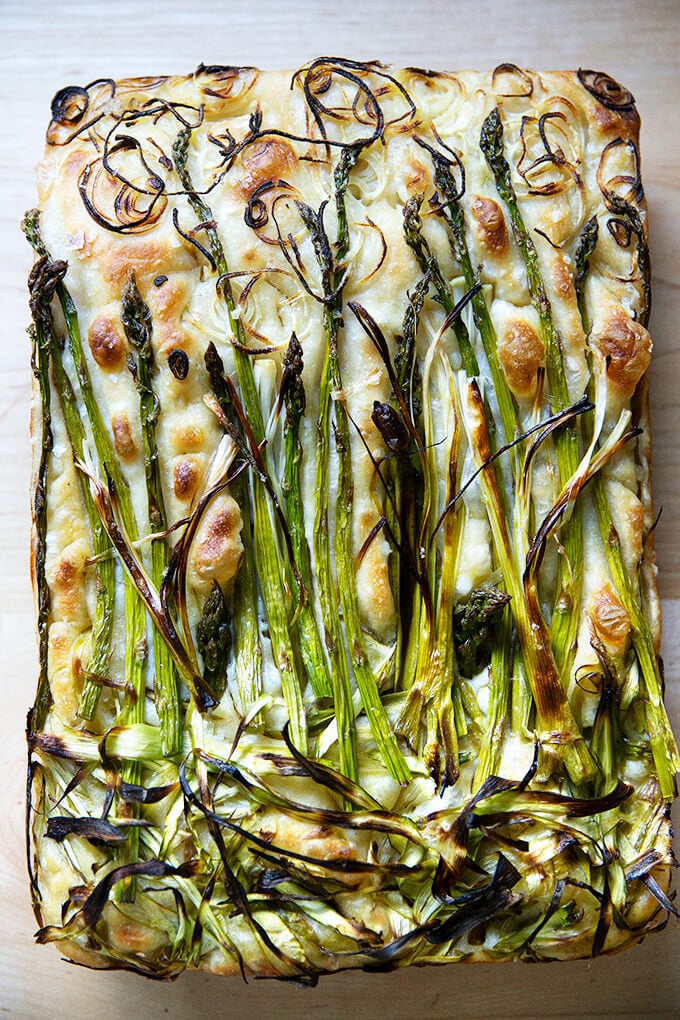
How to Make a Focaccia Bread Art
Pictured above is my “Ode to Spring” (🤣) Focaccia Bread Art (or Garden Scape). As noted above, the key with adding toppings is to slick them lightly with olive oil to ensure they don’t completely char. Keep in mind that some items will char, and a little charring is not a bad thing.
To make a focaccia bread art:
- Follow the recipe through the step in which you dimple the dough just before baking. Arrange your toppings — sliced peppers, asparagus, scallions, olives, tomatoes, onions, etc. — over top and dimple again, pressing the ingredients into the dough to embed them — you can be more aggressive than you think.
- Brush the entire surface with olive oil; then sprinkle with sea salt.
- Bake as directed.
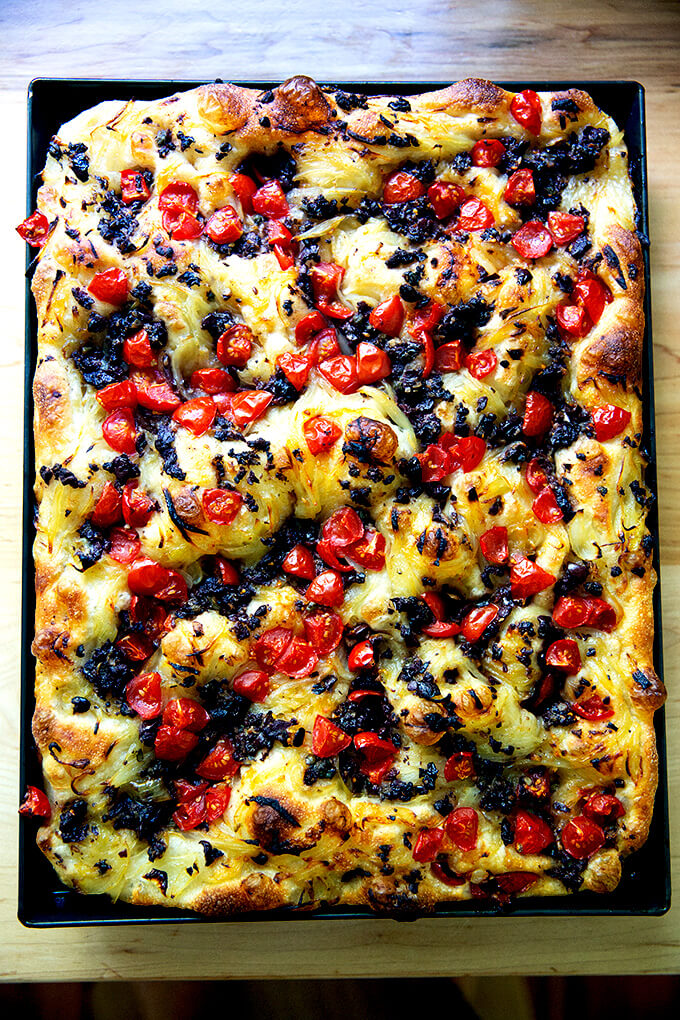
Tomato Focaccia
Pictured above is a cross between pissaladière and tomato focaccia. I love the addition of tomatoes to pissaladière because it adds a freshness and brightness, a hit of acidity to offset the sweet caramelized onions and salty anchovies, olives, and capers.
You can use any summer tomatoes you have on hand — diced cherry tomatoes, Roma, plum, sliced beefsteak tomatoes, heirloom tomatoes, etc. If you choose to dice up Roma or plum tomatoes, there is no need to seed them, but leave any juices lingering on the cutting board behind.
Top the unbaked focaccia with a thin layer of tomatoes; then bake as directed.
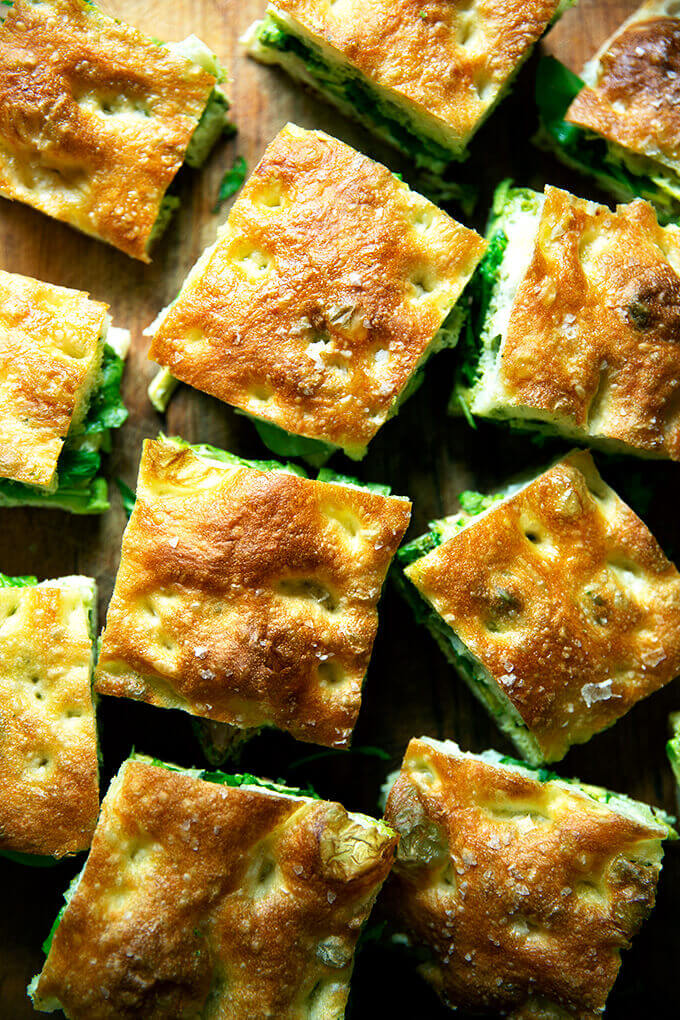
How to Make Focaccia Bread Sandwiches
One of my favorite things to do with either the rounds of focaccia or the 9×13-inch slab of focaccia is to make a giant sandwich: simply halve the whole finished loaf of focaccia in half crosswise; fill it as you wish, close the sandwich; then slice and serve.
Here’s one of my favorites: Roasted Red Peppers, Olive Tapenade, & Whipped Honey Goat Cheese
Can I Make this Overnight Focaccia Without the Overnight Rise?
Yes, you can. In fact, in my cookbook, Bread Toast Crumbs, I do not employ an overnight rise. Start-to-finish it can be made in about three hours. The finished bread will not be as pillowy, but it will still be light, airy, and delicious.
To skip the overnight rise, simply let the mixed dough rise at room temperature until doubled, about 1.5 to 2 hours. Then proceed with the recipe, knowing the second rise will only take about 30 minutes.
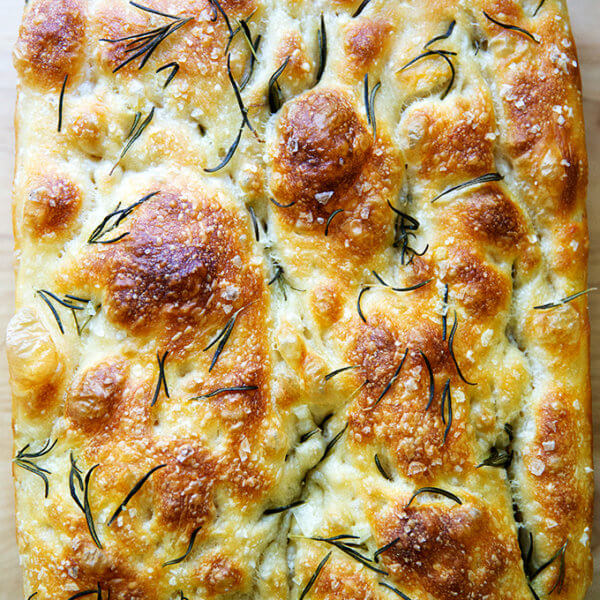
The Best, Easiest Focaccia Bread Recipe
- Total Time: 18 hours 30 minutes
- Yield: 2 loaves
Description
Cold, refrigerated dough is the secret to making delicious focaccia! Allowing the dough to rest 18 to 24 hours in the fridge will yield extra-pillowy and airy focaccia, though if you are pressed for time, you can make this start-to-finish in 3 hours. This 4-ingredient recipe requires only 5 minutes of hands-on time. Video guidance below!
Adapted from the focaccia recipe in Bread Toast Crumbs.
A few notes:
- Plan ahead: While you certainly could make this more quickly, it turns out especially well if you mix the dough the day before you plan on baking it. The second rise, too, takes 2 to 4 hours.
- If you are short on time and need to make the focaccia tonight: Let the mixed dough rise at room temperature until doubled, about 1.5 to 2 hours. Then proceed with the recipe, knowing the second rise will only take about 30 minutes.
- You can use various pans to make this focaccia such as: two 9-inch Pyrex pie plates. (Use butter + oil to prevent sticking.) One 9×13-inch pan, such as this USA pan — do not split the dough in half, if you use this option, which will create a thicker focaccia . A 13×18-inch rimmed sheet pan — this creates a thinner focaccia, which is great for slab sandwiches.
- As always, for best results, use a digital scale to measure the flour and water.
- I love SAF instant yeast. I buy it in bulk, transfer it to a quart storage container, and store it in my fridge for months. You can store it in the freezer also.
- If you are using active-dry yeast, simply sprinkle the yeast over the lukewarm water and let it stand for 15 minutes or until it gets foamy; then proceed with the recipe.
- Flour: You can use all-purpose or bread flour here with great results. If you live in a humid environment, I would suggest using bread flour. If you are in Canada or the UK, also consider using bread flour or consider holding back some of the water. Reference the video for how the texture of the bread should look; then add water back as needed.
Ingredients
- 4 cups (512 g) all-purpose flour or bread flour, see notes above
- 2 teaspoons (10 g) kosher salt
- 2 teaspoons (8 g) instant yeast, see notes above if using active dry
- 2 cups (455 g) lukewarm water, made by combining 1/2 cup boiling water with 1 1/2 cups cold water
- butter for greasing
- 4 tablespoons olive oil, divided
- flaky sea salt, such as Maldon
- 1 to 2 teaspoons whole rosemary leaves, optional
Instructions
- Make the dough: In a large bowl, whisk together the flour, salt, and instant yeast. Add the water. Using a rubber spatula, mix until the liquid is absorbed and the ingredients form a sticky dough ball. Rub the surface of the dough lightly with olive oil. Cover the bowl with a damp tea towel, cloth bowl cover, or plastic wrap and place in the refrigerator immediately for at least 12 hours or for as long as three days. (See notes above if you need to skip the overnight rise for time purposes.) NOTE: It is important the dough really be slicked with olive oil especially if you are using a cloth bowl cover or tea towel as opposed to plastic wrap or a hard lid. If you are using a tea towel, consider securing it with a rubber band to make a more airtight cover. If you do not slick the dough with enough oil, you risk the dough drying out and forming a crust over the top layer.
- Line two 8- or 9-inch pie plates or a 9×13-inch pan (see notes above) with parchment paper or grease with butter or coat with nonstick cooking spray. (Note: This greasing step may seem excessive, but with some pans, it is imperative to do so to prevent sticking. With my USA pans, I can get away with olive oil alone; with my glass baking dishes, butter is a must.)
- Pour a tablespoon of oil into the center of each pan or 2 tablespoons of oil if using the 9×13-inch pan. Using two forks, deflate the dough by releasing it from the sides of the bowl and pulling it toward the center. Rotate the bowl in quarter turns as you deflate, turning the mass into a rough ball. Use the forks to split the dough into two equal pieces (or do not split if using the 9×13-inch pan). Place one piece into one of the prepared pans. Roll the dough ball in the oil to coat it all over, forming a rough ball. Repeat with the remaining piece. Let the dough balls rest for 3 to 4 hours depending on the temperature of your kitchen (Note: no need to cover for this room temperature rise).
- Set a rack in the middle of the oven and preheat it to 425°F. If using the rosemary, sprinkle it over the dough. Pour a tablespoon of oil over each round of dough (or two tablespoons if using a 9×13-inch pan). Rub your hands lightly in the oil to coat, then, using all of your fingers, press straight down to create deep dimples. If necessary, gently stretch the dough as you dimple to allow the dough to fill the pan. Sprinkle with flaky sea salt all over.
- Transfer the pans or pan to the oven and bake for 25 to 30 minutes, until the underside is golden and crisp. Remove the pans or pan from the oven and transfer the focaccia to a cooling rack. Let it cool for 10 minutes before cutting and serving; let it cool completely if you are halving it with the intention of making a sandwich.
- Prep Time: 18 hours
- Cook Time: 30 minutes
- Category: Bread
- Method: Oven
- Cuisine: Italian
This post may contain affiliate links. Please read my disclosure policy.

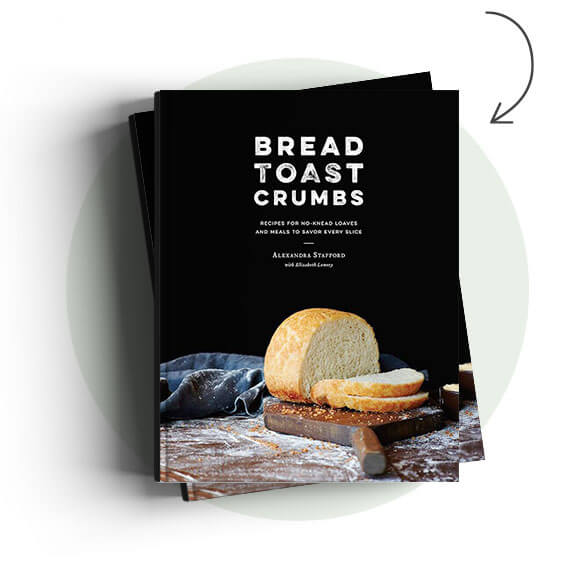

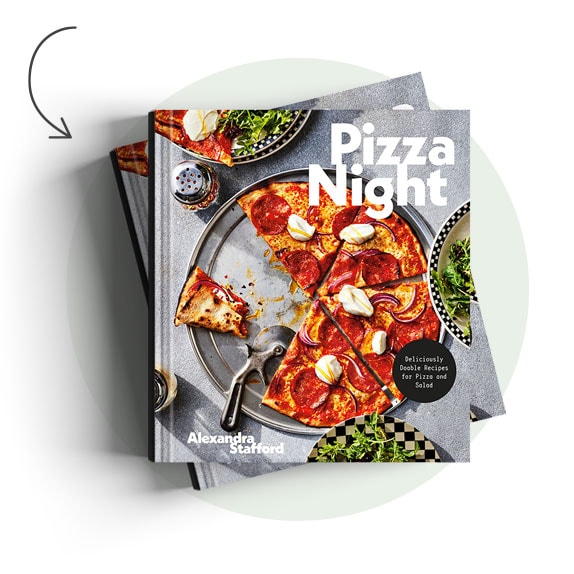


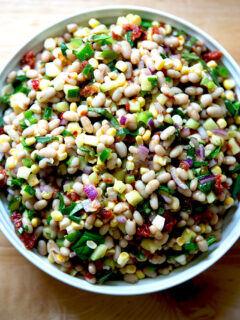
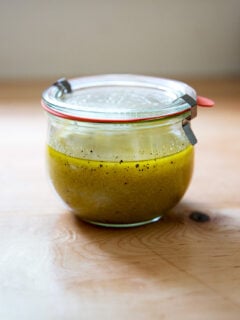
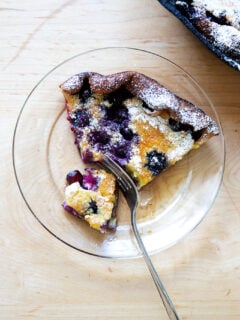


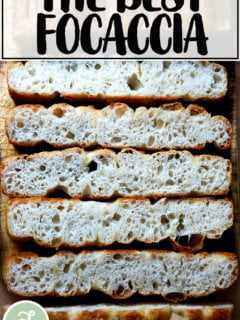
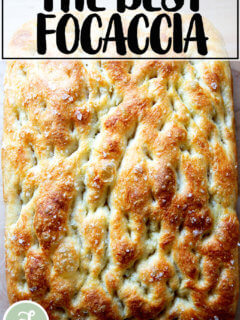
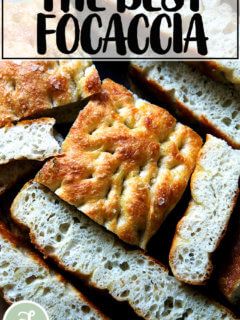
4,117 Comments on “Overnight, Refrigerator Focaccia = The Best Focaccia Bread Recipe”
This is so simple and, with the metric measurements and a scale, foolproof. Came out perfect and delicious. I’ll definitely be making this again and again.
Made the dough yesterday night and baked it today with three separate flavours: olives and oregano; chilli flakes and garlic; and tomato sauce with basil, and some mozzarella sprinkled on after baking. It was a hit and disappeared in a flash!
So great to hear this, Kate! Love the sound of all of your topping combinations. Thanks for writing!
Wonderful to hear this, Liana! Thanks so much for writing 🙂 🙂 🙂
awesome recipe. I mixed in 100g sourdough discard, subtracted 50g water and 50g flour, and only 5 g yeast. Mixed, threw in the fridge and followed directions the next day. Came out scumptious with crisp outside and fluffy inside. My new go-to focaccia recipe!
Awesome! Love this so much, Esther! Thanks for writing.
Good, straight forward recipe. I might add that refrigeration is not required. You can leave your dough out on your counter overnight. Using the refrigerator retards the fermentation process. It is a useful technique,especially if you are baking within 24 hours.
Delicious and flavorful bread.
Great to hear this, Lea 🙂 🙂 🙂 Thanks so much for writing!
This is hands down the best and easiest focaccia recipe I have tried! I’m making it constantly every other day and there is never enough. As soon as I put the dough into the pan, I mix the new batch of dough in the same container. I did find that it turns out better if I bake it not the next day, but the day after. Also turns out better with the King Arthur all purpose flour. Now off to study recipes in your book.
Thank you!
So wonderful to hear this, Iryna! I love your method of immediately making a new batch of dough … so smart. I agree: longer time in the fridge = better. I’ve been loving the results with a 48 hour cold proof. And I agree re KAF, too. Thank you re book… means the world 💕💕💕💕
Made this with dinner tonight and it was fantastic! My family raved about it and I felt so proud. Easy and delicious with great instructions. I can’t wait to try another recipe.
Wonderful to hear this, Yvonne! Thanks so much for writing. Hope you find some other recipes you love.
I just baked this recipe and it turned out beautifully and tasted delicious! Thank you for sharing this amazing recipe!!
Great to hear, Stacey! Thanks so much for writing.
Super easy! Even an inexperienced baker can make this with confidence. It’s light and airy texture is perfect. I have made this several times and each time it’s to rave reviews and requests for more. Love this recipe and will keep coming back to it when I need bread!
So wonderful to hear this, Christy 🙂 🙂 🙂 Thanks so much for writing.
I wish I could give this recipe 10 stars. OMG it was perfectly delicious. I’m an experienced baker, but had never made focaccia until last night. My guests were swooning. Thank you for posting this recipe!!!! I was blown away! THANK YOU!
Awwww I love this 🙂 🙂 🙂 So wonderful to hear. Thanks so much for writing.
Made this tonight. So good! I used an 8″ round cake pan and a 9″ square pan. I think I should have gone with an 8″ square. So easy and so good. Thanks!
Great to hear! Thanks so much for writing 🙂 🙂 🙂
It is the best. My husband adores it. Balsamic and olive oils perfect bread.
Right?! So good 🙂 🙂 🙂
This is hands down my favorite recipe!!! Every time I make it I get such amazing feedback. I’ve turned all my family and friends into bread bakers too!
Any suggestions to making this gluten free? My mom used to love it but was recently diagnosed with celiac. Thanks in advance!
I’m so happy to hear this Camille 🙂 🙂 🙂 Regarding a Gluten-free version, I might start with this recipe, which has a very batter-like consistency, but which you might be able to adapt for focaccia: Gluten-Free Peasant Bread Recipe
This recipe is the bomb! Worth the wait. I Feel like a pro baker. Lol. Im trying out APC this time. Used bread flour the first try it was soft and chewy.
So great to hear this, Diane! Thanks for writing 🙂 🙂 🙂
I saw your post on Instagram and made my second ever focaccia with this recipe. It came out insanely fluffy and absolutely delicious!
Sadly my oven isn’t big enough for the exact recipe so I halved the ingredients. Didn’t have a pan like the one you used (I am in desperate need of more/better kitchenware lol) so I baked in a Pyrex container. You said to butter first then oil with glass pans, so I did that, but maybe overdid it since the focaccia came out with some excess oil at the bottom. However it did perfectly prevent any sticking, so I’m not complaining.
I’m very new to bread baking except for the few times I made bagels, so the “chuck it in the fridge for a whole day” method was very exciting. Thank you for this amazing recipe, I will definitely bake it again!
So wonderful to read all of this! And I love that you were able to make this work with the pans you have on hand. My sister has a small oven as well, and honestly, I like it better than my fancy Wolf oven — everything browns so beautifully in hers.
Thanks so much for writing and sharing your notes!
Two questions, I covered the containers with saran wrap for the second rise, didn’t see anything specific on this. Also, if i wanted to make a small batch, just half everything, even the yeast? Made my second batch just now. thanks for the great recipe.
Hi! You don’t need to cover the dough for the second rise, especially if it’s slicked in olive oil, but there is no harm in doing so. Yes, halve everything a small batch.
Love this recipe! So easy especially for someone like me who never made bread before and now make it all the time.
Yay 🙂 🙂 🙂 So nice to hear this, Norma 🍞🍞🍞🍞🍞
hi! love this recipe and have made it many times. its always so good and a crowd pleaser. do you have suggested modifications for prepping/baking at altitude? i’m at about 8,000 feet right now 🙂 thank you!
Hi Caroline! I would try it as is… many people have had success baking this bread at altitude without making any adjustments. I think it tends to work at high altitudes because it is such a high hydration dough and also the rise is long and slow.
Foolproof and fantastic recipe! I made this for the first time today and I loved it! The Focaccia turned out very well. It was chewy on the inside, but crisp on the outside and the flavours worked so well together. This is delicious and well worth letting it sit overnight. I also let it sit in the fridge for as long as three days and let it rise at room temperature for 4 hours. Just like the recipe says, the longer it rests, the better the flavor. The dough was super bubbly and definitely worth the wait! I topped with fresh rosemary, thyme, cherry tomatoes, freshly ground black pepper and flaky sea salt. The whole house smelled delicious. It was AMAZING! This is now my favorite Focaccia recipe. Looking forward to trying out different toppings and Focaccia Bread Sandwich version. Thank you so much Ali for sharing this recipe and the tips & tricks!
So great to hear all of this 🙂 🙂 🙂 Thanks so much for writing and sharing your experiences.
I did this as directed and it turned out great! I made the rosemary and version. I refrigerated the dough overnight and made it today. I couldn’t believe how easy it was! I got a little carried away while sprinkling the sea salt flakes, so I will cut back next time. This is a perfect with White Bean and Rosemary Soup. Thanks for a fabulous recipe!
So nice to hear this, Amanda 🙂 🙂 🙂 Thanks so much for writing and sharing your notes. I love this with soup so much 💕
Girl, this was my first bread and I fricking LOVED IT. So so tasty!!! Thank you!!
Yay! Great to hear, Jessica! Thanks so much for writing 🙂 🙂 🙂
Simple and incredibly effective recipe. Used active rise yeast, so I followed your tips. Added rosemary, but forgot the salt on top! Still delicious.
Great to hear, Marianne! Thanks for writing and sharing your notes 🙂 🙂 🙂
Yup, it’s the best focaccia recipe there is!!!! I’ve tried MANY recipes and hands down, this is number one, made it on day 2 of the dough hanging in fridge and it was like a cloud, so light and fluffy, amazing!!
So great to hear this, Sarah 🙂 🙂 🙂 Thanks so much for writing. I do think the longer the fridge time, the more cloudlike the focaccia 💕💕💕
I made this and it turned out delicious but not that airy…. Kind of dense. I noticed on my second rise it didn’t grow much. I did 24 hours in the fridge then three hours on the counter for the second rise. It still tasted very good at least! I did use active dry yeast but I’m worried i didn’t put it in warm enough water.
Hi Ashley! Did the yeast foam before you used it? It’s possible an issue with the yeast, but it could be other things, too. Are you using a scale to measure? Try 48 hours in the fridge next time … if you have the patience 🙂
I am so excited to try this – I made the dough last night then realized I didn’t have any large flaky salt for the top and am not seeing any in the store this morning – can I use coarse Kosher salt or just regular iodized salt?
Hi Kristen! Use kosher salt, and just use a light hand. It will be fine!
I am going to try this for sure! I have struggled with baking and this seems pretty easy. Do you think it would work to bake in a cast iron skillet?
Definitely! How large is your skillet? Depending on the size, you may not want to bake the full amount of dough in the skillet.
I measured all the ingredients using a digital scale and my dough never formed a ball. I tried adding more flour and salt. Finger’s crossed and hoping for the best in my fridge!
Absolutely love this recipe!! Instagram blogs and sites are showcasing all your amazing recipes and abilities. Thanks so much for sharing 😊
So nice to hear this, Em! And thanks so much 🙂 🙂 🙂 💕💕💕
Hi Jenn! Where are you located? A humid environment? And what type (brand, variety) of flour are you using?
Not humid, I’m in New England so it’s cold. I used fresh all purpose flour and fresh yeast
Sorry-Gold Medal all purpose flour.
Hi Jenn! OK, this is so interesting. I guess Gold Medal flour must absorb water differently than King Arthur Flour. Next time, definitely reduce the amount of water. Hold back 50 grams or more — you can always add it back in slowly.
With the fresh yeast, did you use 3x the amount of dried by weight?
So I made bread but not focaccia. Still tastes good though!
Hi Ali. I must be doing something wrong, cause my dough is way too wet. I tried three times right after each other. The first time I thought, maybe I got the measurements wrong. It’s rising now, but with 50-100 extra grams of flour in. Tried again, this time with fresh yeast, as I was out of the other, not a lot better, it’s now rising as it is. Tried yet again, this time without yeast as I was now out, but wanted to see if it made any difference at all pouring the water into the flour and not the other way round, I think it did actually, but not a lot. It’s in the bin 🙂 Any suggestions to what goes wrong? Do I have to mix it longer, water too hot?
Hi Lasse! Where are you located?
My suggestion would be rather than increase the flour, decrease the amount of water. Great that you are using a scale, which makes troubleshooting much more accurate/effective.
I do always whisk together the flour, salt, and yeast. Then I add the lukewarm water (about 105ºF – 110ºF). But it shouldn’t matter if you add the water to the dry ingredients or vice versa.
With fresh yeast, you should be using 3x as much by weight as dried yeast.
Can you clarify: are you not using any yeast at all in the third batch?
I make this for parties and the like and my friends go crazy for it, always a giant hit 😀
So great to hear this Ula 🙂 🙂 🙂 Thanks so much for writing 💕
Hi! I am from Mexico City! Thanks for sharing your recipe. I love to bake cakes, pound cakes and sweet stuff but I had never used yeast before. Today it was my first time! I started yesterday and follow the recipe exactly but I did half batch cause we are only 2 at home. Everything was as you described, my only thing is that 25 minutes baking was not enough because it was pale, so I left it 15 more minutes (checking it every 5 minutes) in the oven until it turned a beautiful golden color. I sprinkled at the top before baking sea salt, rosemary, grated Parmesan cheese and 4 sun dried tomatoes I had. In spite of being 40 minutes at the oven it turned out pretty soft and like a pillow. It stocked a bit to my Pyrex but it didn’t break when I took it out. I didn’t use butter, only olive oil. But it turned out crispy on the outside and soft on the inside! Lively recipe! I have a question: if you are including for example olives do they go at the top just before baking it? Or should they be mixed on the dough? Thanks again for your recipe! I’m sure I will keep doing it!!!
Great to hear all of this Veronica! Using butter before the olive oil will help prevent sticking to the Pyrex. You can add ingredients such as olives directly to the flour — toss it to coat; then proceed with the recipe. You can also use them as toppings, but toppings such as olives and sun-dried tomatoes tend to burn a bit, so I prefer adding them to the dough.
Why not cover the pans in plastic wrap during the 3-4 hour proof? Wouldn’t the dough get very dry?
Because it is slicked in oil, it actually will not dry out. Some people like to cover it, especially in the summer when fruit flies abound, but there isn’t really a need. Do so if you wish!
I think it is best to use either a damp tea towel or plastic wrap when refrigerating the focaccia overnight. I used the bowl cover like in your picture but the top of the dough was dried out (maybe I should have wet it?).
Fabulous recipe!!
Hi Annie! Yes, I would agree! I recently added a note to the recipe … not sure if you saw it or if you’re working from an older, printed copy. I acutally use a lidded 4-qt bowl now for fridge rises. The lid really helps prevent a crust from forming. Thanks for writing!